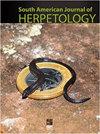Historical Biogeographic Reconstruction of the South American Liolaemus boulengeri Group (Iguania: Liolaemidae)
IF 0.7
4区 生物学
Q4 ZOOLOGY
引用次数: 0
Abstract
Abstract. The Liolaemus boulengeri group is part of the subgenus Eulaemus, genus Liolaemus. This group is widely distributed in Argentina, Bolivia, Chile, and Paraguay, as well as in the Peruvian Titicaca basin and the coasts of Brazil and Uruguay. Here, we combined the revision of a fossil record of Liolaemus, dated at 20 million years (Myr), with relaxed molecular clock analysis to provide a time-calibrated, molecular-based phylogenetic hypothesis including 90% of the group's known species. We found the Liolaemus boulengeri group (= L. boulengeri section) formed by three main groups, the L. wiegmannii, L. anomalus, and L. darwinii-melanops groups. We performed biogeographic analyses applying Bayesian Binary (BBM), Dispersion-Extinction-Cladogenesis (DEC), and Statistical-Dispersion-Vicariance (S-DIVA) and found that the ancestral area of the L. boulengeri group was likely located in central-west Argentina and reached its current distribution after a series of dispersal and vicariance events. These processes may have been favored by a period of climatic stasis which occurred at the beginning of the group's diversification, around 41 Myr. The congruence of the results of all three biogeographic analyses evidences new hypothetical historical distributions and events which led to the current species distribution of the L. boulengeri group. Resumen. El grupo de Liolaemus boulengeri es miembro del subgénero Eulaemus, dentro del género Liolaemus. Este grupo se distribuye en Argentina, Bolivia, Chile y Paraguay, así como en el sureste de Perú, en la cuenca del Titicaca y las costas de Brasil y Uruguay. En este trabajo obtuvimos una hipótesis filogenética basada en evidencia molecular, incluyendo el 90% de las especies conocidas para el grupo. También, obtuvimos un árbol temporalmente calibrado, usando un reloj molecular relajado y un registro fósil de Liolaemus, datado en 20 millones de años. Encontramos al grupo de Liolaemus boulengeri (= sección de L. boulengeri) formado por tres grupos principales, los grupos de L. wiegmannii, L. anomalus y L. darwinii-melanops. Realizamos un análisis biogeográfico aplicando: Bayesian Binary (BBM), Dispersion-Extinction-Cladogenesis (DEC) y Statistical-Dispersion-Vicariance (S-DIVA), encontrando que el área ancestral del grupo de L. boulengeri está ubicada en el Centro-Oeste de Argentina. Desde ahí, debido a una combinación de eventos de dispersión y vicarianza, las especies de este grupo alcanzaron su distribución actual. Estos procesos podrían haberse favorecido por un periodo de estasis climática que ocurrió al comienzo de la diversificación del grupo, hace alrededor de los 41 millones de años. La congruencia de los resultados de los tres métodos nos permitió hipotetizar las distribuciones históricas y los eventos que podrían haber afectado la distribución actual de las especies del grupo de L. boulengeri.南美洲布列格里群的历史生物地理学重建(Iguania:Liolaemidae)
摘要。Liolaemus boulengeri群是Eulaemus亚属Liolaemus的一部分。这一群体广泛分布在阿根廷、玻利维亚、智利和巴拉圭,以及秘鲁-蒂蒂卡卡盆地和巴西和乌拉圭海岸。在这里,我们将2000万年前Liolaemus化石记录的修订与放松的分子钟分析相结合,提供了一个基于时间校准的分子系统发育假设,其中包括该群体90%的已知物种。我们发现Liolaemus Boulengeri组(=L.Boulengeri部分)由三个主要组组成,即L.Wiegmannii、L.Anomalus和L.Darwinii-Melanops组。我们使用贝叶斯二元(BBM)、分散-灭绝-分支发生(DEC)和统计-分散-代孕(S-DIVA)进行了生物地理分析,发现L.布朗格里集团的祖传地区可能位于阿根廷中西部,经过一系列分散和代孕事件后达到了目前的分布。这些过程可能得益于该集团多样化开始时发生的一段时间的气候停滞,约为41 MYR。所有三项生物地理分析结果的一致性证明了新的假设历史分布和事件,这些假设历史分布和事件导致了L.Boulengeri群的当前物种分布。总结。Liolaemus Boulengeri组是Liolaemus属中Eulaemus亚属的成员。该群分布在阿根廷、玻利维亚、智利和巴拉圭,以及秘鲁东南部、蒂蒂卡卡盆地以及巴西和乌拉圭海岸。在这项工作中,我们根据分子证据得出了一个系统发育假设,其中包括该群体已知物种的90%。此外,我们还获得了一棵临时校准的树,使用了一个放松的分子时钟和一个可以追溯到2000万年前的Liolaemus化石记录。我们发现Liolaemus Boulengeri组(=L.Boulengeri的部分)由三个主要组组成,即L.wiegmannii、L.anomalus和L.darwinii-melanops组。我们应用贝叶斯二元(BBM)、分散-灭绝-分支发生(DEC)和统计-分散-替代(S-DIVA)进行了生物地理分析,发现L.Boulengeri群的祖先地区位于阿根廷中西部。从那时起,由于分散和替代事件的结合,这一群体的物种达到了目前的分布。这些过程本可以得到大约4100万年前该集团多样化开始时发生的气候停滞时期的支持。这三种方法结果的一致性使我们能够假设可能影响L.Boulengeri种群物种当前分布的历史分布和事件。
本文章由计算机程序翻译,如有差异,请以英文原文为准。
求助全文
约1分钟内获得全文
求助全文
来源期刊
CiteScore
1.50
自引率
0.00%
发文量
10
期刊介绍:
The South American Journal of Herpetology (SAJH) is an international journal published by the Brazilian Society of Herpetology that aims to provide an effective medium of communication for the international herpetological community. SAJH publishes peer-reviewed original contributions on all subjects related to the biology of amphibians and reptiles, including descriptive, comparative, inferential, and experimental studies and taxa from anywhere in the world, as well as theoretical studies that explore principles and methods.

 求助内容:
求助内容: 应助结果提醒方式:
应助结果提醒方式:


